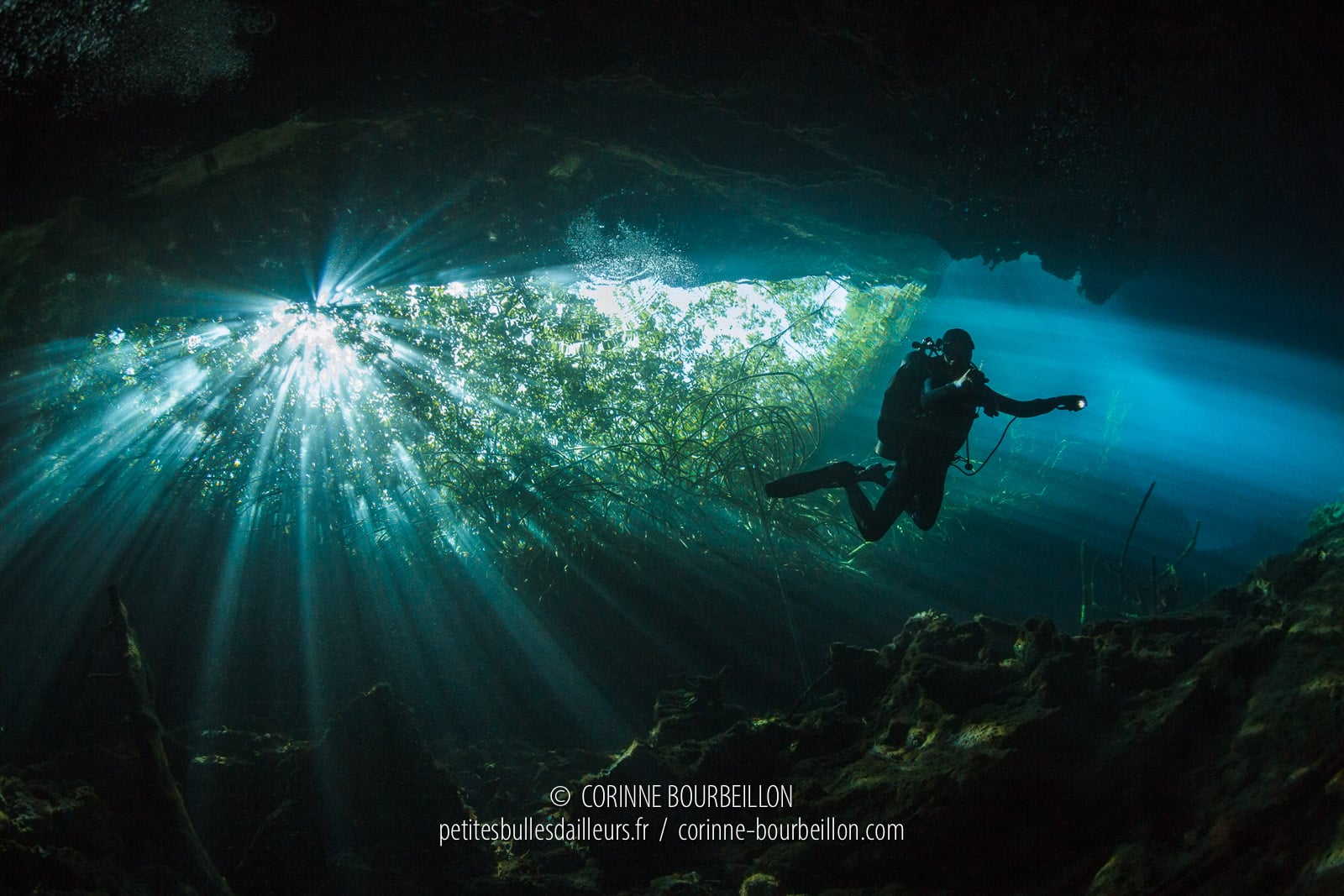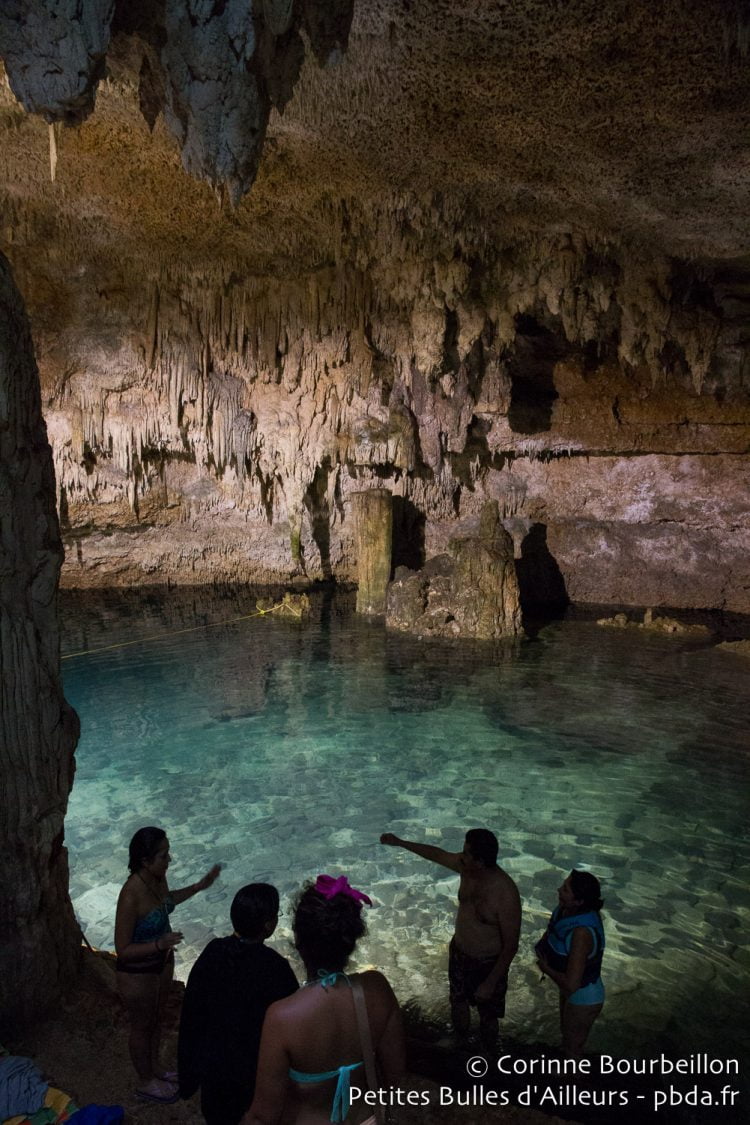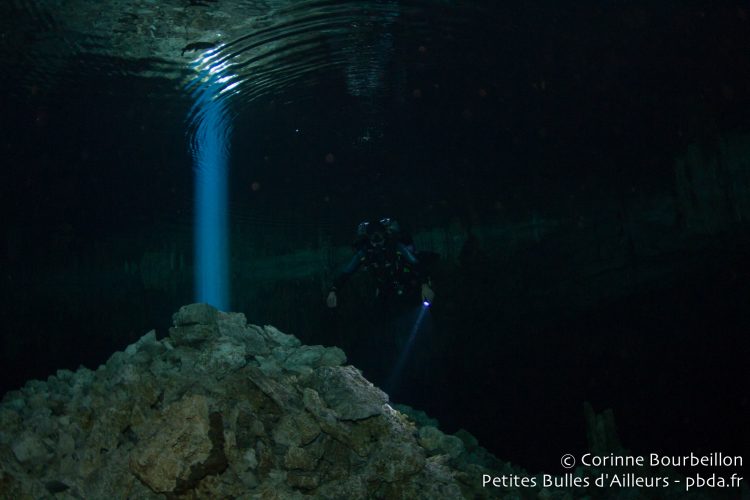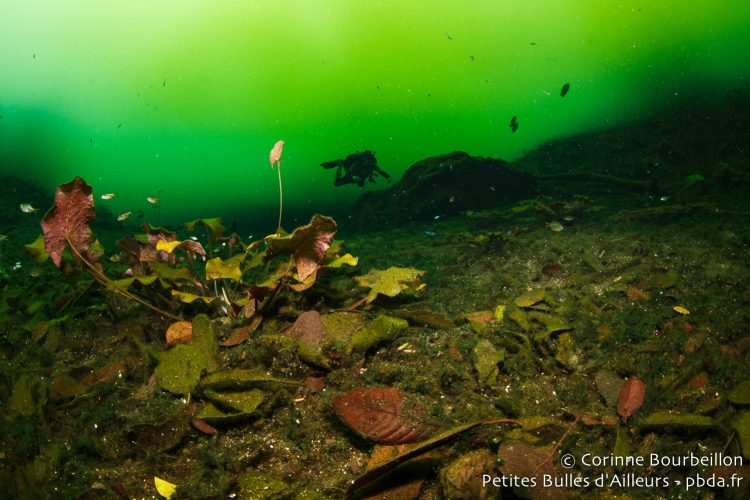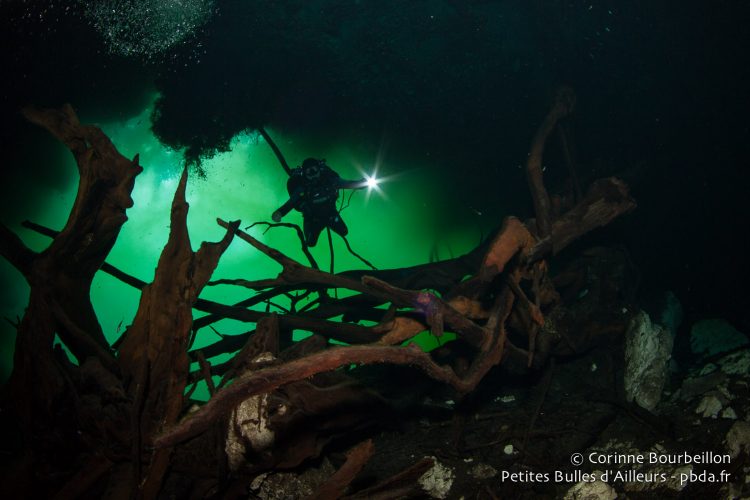Dear English-speaking readers, this page is an automatic translation of an article originally written in French. I apologise for any strange sentences and funny mistakes that may have resulted. If you read French, click on the French flag below to access the original, correct text:
In Mexico, the Yucatán peninsula is like a Swiss cheese, pierced by fresh water holes, called "cenotes". Sacred for the Mayas, the cenotes are today bathing places... and diving spots!
What are the cenotes?
The word maya "tzonot" or "d'zonot" gave "cenote" in Spanish (pronounce ce-no-te). They are holes, chasms, formed by the collapse of the limestone, filled with fresh water.
The largest concentration of cenotes is found in Mexico, in the Yucatán peninsula. They are everywhere, of all sizes, scattered in the jungle, but also in the heart of towns and villages, which have developed around these natural wells.
Above : the superb Ponderosa cenote, also called Garden of Eden, and the Valladolid cenote, adjacent to a bar-resto in the heart of the city. Signs warn of the danger for the unwary who would like to dive. (Mexico, July 2014)
A unique geological phenomenon
In the north of the Yucatan Peninsula, there is a series of cenotes that are arranged in a ring, all around the Chicxulub crater. That is why it is thought that they were created by the impact of a meteoriteIt could even be the meteorite that caused the extinction of the dinosaurs!
Below are some diagrams found on websites, which allow you to visualise the trick.
![The Yucatán cenotes were born from the impact of a meteorite. [Sources: Dailymail.co.uk / Secretebase.free.fr / Timwilko.com / Mayantreasure.net]](https://petitesbullesdailleurs.fr/petitesbullesdailleurs/wp-content/uploads/2014/09/cenotes-web-770x462.jpg)
Subterranean fractures connecting Mexican cenotes form a huge network of galleries and sunken cavesThe water table can be connected to the water table or, near the coast, to the sea.
For the Maya, these water holes were sacred placesa mouth open to the other world. Some cenotes were places of worship, where offerings were thrown and sacrifices were made, of animals and human beings.
Find out more → Wikipedia on the cenotes
A strange animal, the coati
When the cenotes are in the middle of the jungle, you can sometimes see a strange creature emerging from the cover of the trees. Long nose, clawed legs, long bushy tail.
A coati. The Mexican version of the raccoon.
Standing on its hind legs, this coati has taken the habit of begging for food from tourists. This funny animal is a cousin of the raccoon. (Mexico, July 2014)
The tourists who picnic attract the coatis. They do not hesitate to beg for a piece of sandwich, standing on their hind legs. The animal reminded me Indonesian cuscus…
But let's get back to the cenotes.
Bathing places
Today, the cenotes have become tourist attractions. The surroundings of the most famous ones are equipped to allow swimming, snorkeling (fins-mask-tuba), scuba diving.
Showering is mandatory before swimming in some cenotes, to avoid that sun creams and anti-mosquito products pollute the water.

The cenotes most frequented by bathers are in the open air, surrounded by trees, open to the outside. But you can also splash around inside cenotes that are completely buried under the ground: you reach these caves via a staircase that goes down in a spiral or steeply in the rock. At the bottom, a generator provides the light... I visited several of them, one of them at 18 m under ground!
Swim in an incredibly clear and pure waterunder a ceiling of stalactites, along which sometimes hang tree roots, is an extraordinary experience. But to feel the magic of the place, it is better to avoid groups, always noisy ...
Above, an underground cenote. (Mexico, July 2014)

Diving among the Mayans
The cenotes, I've been dreaming about it for a long time. It was my main motivation as a diver-photographer (with whale sharks) to fly to Mexico, instead of going to Asia as I do almost every summer.
I confess: I never dive in fresh water, I am not particularly fond of caves, even when dry, and cave diving does not attract me more than that. But the spectacular underwater pictures, made by other divers in the famous Mexican cenotes in the middle of the jungle had captivated me. And I wanted to see it with my own eyes! So, this summer, I fell in love. I went there in my turn, to make my own pictures...


Feel like Indiana Jones underwater
Some cenotes give access, via galleries full of water, to underground rooms, whose ceiling is pierced by openings, more or less wide, to the outside. When the hole is small, the sun rays that pass through make like blue laser beams in the water!
Above, images from the Tajma Ha cenote. (Mexico, July 2014)
I came for the unique light effects, particularly beautiful in the cenotes where I chose to dive: Ponderosa (Garden of Eden), Tajma Ha, Car Wash, Grand Cenote.
It is difficult to explain, to share the absolute fascination that this kind of place gives me. What could be more exhilarating than to photograph together water, light, mineral and vegetal, united here by a unique geological chance!
I lived in the cenotes magical momentsThe experience is unique and unprecedented. Nothing to do with diving in the sea. To immerse oneself in the chasms venerated by the ancient Mayans, it is not nothing.
Feeling Indiana Jones underwater is exhilarating. In the cenotes, I was 10 years old again!

haloclines
Another strange phenomenon in the cenotes, that I could experiment in particular in Tajma Ha Where a layer of fresh water is superimposed on a layer of salt water, the water seems to separate in two. We have the impression of a line, as when we are on the surface, between the air and the water. Except that we are immersed, in a gallery full of water.
I don't have a picture that can show you that... You look down and up, you feel like you are going in and out of the water. But not at all. We are always immersed. Very disturbing, very disturbing. This is called a "halocline". Fortunately I had been warned about it before diving, because at the time my poor brain could hardly understand what was happening. Especially since the phenomenon in question occurs when we are in a totally underground environment, without any external light. Almost frightening, I admit.
The underwater signs with skulls indicating the entrance of galleries that are risky to explore impressed me less than this strange sensation of half air half water, regulator in mouth, in a crystal clear water...


Above, the underwater panels at Grand Cenote and Taj Maha. (Mexico, July 2014)
Diving à la carte
Some practical information... I really wanted to explore the cenotes in good conditions to take pictures. So I decided to a small structureI know from experience that it would be easier to "personalize" my requests than in a large center.
My choice was O2 Mexicobased in Playa del Carmen, which I contacted before leaving. This will be the only thing planned a little in advance in this trip to Mexico.
Good luck! Great reception, great service. With customised and almost private diving: I ended up just with a buddy or alone with a guide. In short, luxury according to my criteria.
My guide in the cenotes, Clément Prandi, is himself an underwater photographer (see his site Facebook Mystic Vision). He was therefore particularly sensitive to my wishes and even paid with his person, regularly playing the models, always going to the right place at the right time for my images...

Cenote Car Wash
Clement suggested that I visit, south of Playa del Carmen, near Tulum, this special cenote, called Car WashBacteria form a kind of opaque layer on the surface.
The atmosphere is different, strange and ghostly. A spectacular place, again, for underwater photos ...
The Car Wash cenote gives access to a cave and galleries, where, at the entrance, big tree roots and stalactites follow one another... Plant cathedral and mineral cathedral. The whole in a water capped by a green ceiling, opaque, which lets pass only a diffuse light.
It's both beautiful and a little scary. But Indiana Jones and Crocodile Dundee were watching over me.
There is a small crocodile, a real one, that lives in this cenote. I was hoping to at least photograph its silhouette against the light. But he was hidden somewhere, in the mangrove, and did not deign to play the extras... So Clément paid of his person and took the pose for my photos.
Water temperature
Finally, a word to my diving readers, who always want to know which wetsuit to take in their luggage... In the cenotes, the water is "fresh" according to my criteria. About 24-25 ° C.
🥶
Yes, it is cold compared to the sea, which is 28-29°C in July on the Caribbean coast of Mexico.
For the simple bathers, swimmers, snorkelers, to immerse in the cenotes, it is very pleasant... In particular when it reigns a crushing tropical heat outside, as it is the case in July in Mexico. We paddle the time we want to refresh ourselves, we go out when we have enough.
But for divers, it's totally different, you don't feel the water temperature at all in the same way.
This is one thing that I often have trouble making my non-diving friends understand, especially those from Brittany... For them, water that exceeds 17°C is just science fiction and they find it "good" as soon as 14°C!
😂
In fact, in water, heat exchange is much faster than in air (water conducts heat 25 times faster than air) and we cool so very quickly.
The temperature of thermal neutrality for the human body, i.e. at which heat loss and production are balanced, is 24 to 26°C in the air, against 33°C in water.
My little person being more sensitive than average to these physical and physiological laws (a complicated way to say I'm cold), I put on a 5 mm hooded shorty, over my old long suit (also 5 mm), to be able to last an hour underwater without coming out completely cold. It went very well, the double layer was effective.
I therefore recommend extra protection for the most chilly, to explore the cenotes. The hardcore can try a simple 5 mm wet suit without any hoody. But it will be more comfortable with an extra layer.
In conclusion
The cenotes are great. A must do if you are traveling in Mexico, whether you are a diver or not.
These are spectacular, magnificent places. Accessible to all. And for the saltwater divers, the experience is really different, rich in strong sensations. Unforgettable.

😎
Find the other articles on this trip to Mexico by clicking on the link below ...

